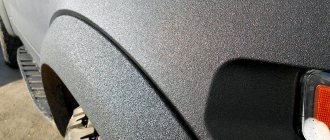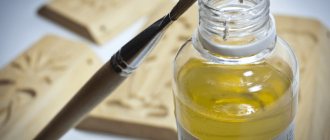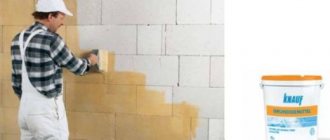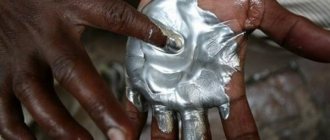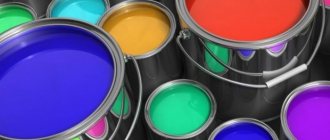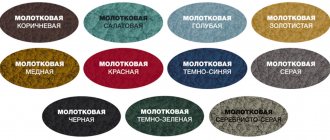Paint and varnish materials used for fire retardant treatment of steel, wood, and in some cases reinforced concrete structures are a new type of similar product that has replaced traditional structural passive fire protection, for example, fire-resistant plasterboard; as well as fire retardant plasters.
Fire-retardant multi-layer coatings - paints, varnishes - make it possible to cover load-bearing building structures, including complex shapes, such as trusses, spans of building coverings, at low consumption; without spoiling their appearance, which is important for architects and designers.
Fire retardant paint on metal structure
Types and scope
Such special coatings perform a double function - they decorate surfaces, like other high-quality paint and varnish products, and reliably protect them from exposure to open fire; high temperature flows; contact with oxygen, preventing metal and reinforced concrete structures from quickly heating up, deforming, and wooden elements of buildings igniting and burning.
There are 2 types of such paints:
- Intumescent paints are the most common group of paints that can increase in volume many times over when the ambient temperature rises, effectively insulating the protected surface from fire and heat.
- Non-swelling , non-expanding even in direct contact with open fire. Their basis is silicates, often called liquid glass, which create a dense film on the protected surface, impenetrable to the heat flow from a developing fire. Their disadvantage is the high consumption of material, approaching fire-retardant plasters, and lower fire-retardant efficiency compared to thermally active paints.
Application area:
- Application on the surface of the load-bearing steel frame of buildings, public and industrial structures - beams, trusses, spans, columns, supports; serving as an effective, modern method of fire protection for metal structures.
- Internal processing of load-bearing structures, building elements made of wood, such as half-timbers, beams, ceilings, columns; panels for finishing walls and ceilings on escape routes and exits. This is a much more effective way of fire protection for wood than fire retardant impregnation.
- Covering of transit ducts of ventilation systems, cable ducts, routes; pipelines of life support systems passing through premises with a high explosion and fire hazard category.
Intumescent fire retardant paint after exposure to flame
Composition and features
It may seem that fire-retardant paints are the least trustworthy compared to other existing methods of protection. Why exactly do they work the way they should? First of all, it should be noted that such paints are intended for painting surfaces and protecting them from exposure to fire. That is, even if a fire occurs, the flames will not be able to spread further to all other areas or the house.
Fire-resistant paint of any type (for example, Neomid) is a mass that has the ability to harden instantly.
The material is obtained when the following ingredients are mixed in certain proportions:
- glass with potassium or silicate in liquid form;
- pigments with a coloring effect;
- fire-resistant fillers (kaolin wool, perlite and talc bases, fluffed asbestos materials);
- special additives with various properties that improve the thermal barrier.
Binders, together with pigment and fillers, take up the most space in the total volume. The binder inside the fire-retardant paint is the same glass, only in the form of a liquid. Color pigments are used to give a material a certain shade. The filler provides the fire-retardant paint with the ability to resist fire, even open fire.
The binder promotes the appearance of a protective film when the mixture dries. This is how any fire resistant paint works.
Fire retardant paints are produced in two-packs. The contents of both containers must be mixed before direct use. Typically, the two main components are the binder mixture and the substance in dry form. Sometimes it is permissible to add clean water to fire-bioprotective compositions, up to 15 percent. The mass remains suitable for use for 6-12 hours.
Properties and composition
There is a group of technical standards that determine the fire-retardant effectiveness, testing methods of such paint and varnish products for various types of protected surfaces of structures and products:
- GOST R 53292-2009 – for fire-retardant paints for wood and wood-based materials.
- GOST R 53295-2009 – for metal elements of buildings.
- GOST R 53311-2009 – for cable coverings.
According to these regulatory documents, the fire-retardant efficiency group of metal paints varies from group 1 with a fire resistance limit of 150 minutes to group 7 with a limit of 15 minutes; and for wooden structures, transfer to group G1 is optimal, which allows it to lose no more than 9% of its mass during fire, which serves as maximum protection for wood.
The composition of fire-retardant paints is very diverse, saturated with various chemical components, and in most cases, manufacturers do not disclose it. Like medieval alchemists, their specialists continue to search for more and more effective formulations that are affordable for the production of finished paint and varnish products, but general open information is still available.
Externally, practically no different from other industrial and household paints, fire retardant compositions are mainly produced on a water-based, water-dispersion basis using various polymers, such as acrylates, polyvinyl acetate, butadiene-styrene. This ensures both fire safety in the workplace during fire retardant treatment and no need for personal protective equipment for workers.
There are the following main types of fire retardant paints, differing in their composition and formulation:
- Acrylic one-component thermally expanding paint, the most widely used, combines perfectly with alkyd primer GF-021. It comes in white and gray - these are the two most common colors, universally suitable for public and industrial facilities.
- Water-dispersion paint with PVA - polyvinyl acetate, or water-based with other polymers that form stable emulsions; fillers for which are thermally active graphite, vermiculite, and other mineral materials.
- Moisture-resistant and even weather-resistant fire retardant paint is an epoxy composition on an organic basis using solvents - xylene, white spirit.
Although structural fire protection is considered more effective than applying multi-layer coatings, modern fire-retardant paints have already come close to it in their technical characteristics, which allows architects and designers to think about; and for designers and builders to calculate and erect buildings and structures of large internal volume with a load-bearing metal frame, without deviating from the requirements of fire safety standards.
Popular products and their descriptions
- Fire retardant paint Terma Lux. The material is intended to protect various metal structures and products used in non-aggressive environments where air humidity does not exceed 80%. This is an intumescent fire retardant paint, which is an environmentally friendly product as it is made on a water basis. Thermolux is available for sale in finished form; as for the palette, this fire-retardant paint for metal is exclusively white.
- Fire retardant paint Phoenix STS. The material is a viscous mixture, also white, but, unlike Terma fire-retardant paint, here the basis is organic solvents. The paint is intended for coating metal structures and can be used both indoors and outdoors. Temporary fire resistance indicators range from 15-120 minutes.
- Fire retardant paint Eureka. It is a water-based product of the intumescent type which produces gases when ignited. This fire-retardant paint is used for wood and products made from it; the composition can be used in unheated rooms. Advantages include moisture resistance, high adhesion to the surface and crack resistance.
- Fire-retardant paint Protect F. The material is designed to provide fire protection for various metal structures, the time indicator of fire resistance is from 40 to 90 minutes. Composition Protect is water-based, which means this non-flammable paint is safe both during application and during use. When painting exterior surfaces, it is recommended to apply a layer of weather-resistant varnish to the coating.
- Fire retardant paint Akvest 01. The product is designed specifically for the protection of wooden surfaces and cable networks, creates a matte coating with high heat resistance properties. This is a fire-retardant intumescent paint, that is, when exposed to high temperatures, it creates a foamy layer. Used exclusively for interior work. Fire-retardant paint for air ducts Akvest 01v with similar properties is also on sale.
- Fire retardant paint Thermal barrier. This is an innovative design that can be used for outdoor use and can withstand any weather conditions. Thermobayer paint is intended for coating steel structures. The fire retardant intumescent base is capable of providing a fire resistance rating of 30-120 minutes.
- Fire retardant paints Titan. They are one-component compositions on a water-dispersion basis, intended for metal surfaces. The coating created by Titan fire retardant paint can withstand fire resistance up to 120-130 minutes. Another feature of Titan fire retardant paints is their repeated swelling when exposed to heat.
- Fire retardant paints ozk 01. Water-based compositions designed to protect load-bearing metal structures. The coating formed by fire retardant paints OZK 01 is subject to repeated swelling when exposed to high temperatures. There is another variety of such fire-retardant paints on sale - OZK-45. These are compositions based on polyvinyl acetate dispersion, they require finishing and the ability to obtain different shades.
- Fire retardant paints Avangard. These are also intumescent-type compositions designed to increase the level of fire resistance of metal structures. The resulting coating has extremely low thermal conductivity.
- Fire retardant paint VUP. The product is intended for painting metal structures in both residential and industrial buildings with a humidity level of no more than 85%. The paint can protect the surface from fire for 90 minutes. Fire retardant paint VUP-2 is available in a standard white color, but it can be tinted in pastel shades. There is also fire-retardant paint for concrete VUP-2B.
- Fire retardant paint Unicum. This product is based on gas- and foam-forming fillers; it is thanks to them that the composition is able to provide a high degree of fire resistance for up to 60 minutes. The paint is intended for painting primed metal surfaces.
In addition to those listed above, the following fire-retardant paints are also popular: Nertex, Krauz-R, as well as compositions Neomid (Neomid), Defender m (Defender), Ograx paint (and the second type of Ograx BB). When choosing a material, it is important to check its quality. To do this, we recommend asking the seller for a certificate for the product.
Review of fire retardant paints (2 videos)
Products of different brands (30 photos)
Application order
How to apply fire retardant paint? This question is far from idle, because such special paint and varnish products during the work process have their own differences from household coatings.
Treatment of the protected surface for both external and internal work, including walls and floors, should be carried out several times with thorough drying of each layer of coating.
Applying fire retardant paint to metal structures
There are 4 main stages when working with fire-retardant paints, the correct implementation of which is the basis for success:
- Preparation of the protected surface. This is an extremely important stage, the results of which directly determine whether the fire-retardant coating will serve reliably for years or whether it will peel off and literally fall off the protected building structures in a matter of weeks. The main work at this stage is cleaning the surfaces from layers of previously applied varnishes, paints, and primers; any types of contamination - dust, technological deposits, salts, rust. They use mechanical and/or chemical cleaning methods - this is the use of abrasive power tools, hand tools, sandblasting machines; as well as rust converters, solvents for removing previous paint. After this, the entire protected surface should be thoroughly degreased, for example, with acetone.
- Application of primer has two important objectives - protecting the surface from corrosion and rotting; improving adhesion for subsequent application of a layer of fire retardant paint; reducing the risk of peeling and cracking of the paint layer. Quite often it is recommended to use the universal alkyd primer GF-021, which requires at least three days to dry completely before painting.
- Painting is carried out depending on the complexity of the conditions of the work site, the total area of the metal structures being protected using brushes, rollers or spray guns, and airless spray stations. Painting must be carried out in strict accordance with the manufacturer’s instructions, only then will the fire retardant coating last a long time; and also during the work process, the consumption of fire-retardant paints per 1 m2 will correspond to that stated in the technical documentation; There will be no overspending or unnecessary costs not taken into account in the estimate.
- Applying a finishing coating, most often a fire retardant varnish produced by the same company; or a coating that protects against moisture and ultraviolet rays.
Additional material: Fire retardant varnishes
Features of water-dispersion paint
Water-dispersed types of fire-retardant paint, including for walls, are classified as intumescent materials. When the surface is exposed to heat, the use of compounds such as fire retardant intumescent mixture creates a special protective shield, which leads to the formation of foam in a hardened form. This paint option provides fire protection for:
- wooden surfaces inside buildings;
- plywood products;
- wood-shaving bases;
- wood fiber materials.
Water-based paints are suitable for interior work, that is, they can cover any wooden structures, products and surfaces that are located exclusively indoors. Such compositions include fire-retardant paints Titan, Negorin, Pyrex. They cover floors, walls, ceilings, attic structures, shelving, etc.
It is not recommended to use water dispersions for outdoor use. It's all about their main component - water. If you paint exterior surfaces with water-based paint, the coating will simply wash off under the influence of constant rainfall.
Fireproof water-dispersion paints are also divided into several varieties. Thus, there are butadiene-styrene compositions, materials containing acrylic, as well as paints based on PVA glue. The latter option has the lowest prices, and the consumption of fire retardant paint of this type per 1 m2 is minimal.
The process of forming a refractory layer
A layer of fire-retardant paint applied to the surface is indistinguishable from conventional coatings, but when exposed to high temperatures, usually around 350℃, due to its intumescent properties, it begins to behave in an unusual way.
The intumescent properties of fire-retardant paints are the ability to swell, expanding tens - up to 70 times in volume, upon strong heating, forming, in the process of active thermal decomposition, a fire-resistant, heat-insulating coke layer that reliably protects the surface of metal and wood structures from open fire and high temperatures ; as well as from contact with O2, which prevents the combustion process of organic matter.
Certificate of conformity
Such an official document, often called a fire safety certificate, is a mandatory accompaniment for any delivery or purchase of fire-resistant paint and varnish products; certifying that this is a quality product that meets the requirements of fire safety standards.
Certification of fire-retardant paint is required both for domestic serial products and for batches of imported fire-resistant coatings. There is no point in purchasing or using fire retardant paints without a fire protection certificate.
Advantages
The period of use of such special paint and varnish products in our country is more than three decades, therefore, based on the accumulated experience, we can draw informed conclusions about the advantages of their use during construction and reconstruction of buildings with metal, wooden structures, and finishing elements:
- These are effective, safe, often universal products, ready for use, supplied to customers in a variety of convenient packaging and containers.
- Several possible application methods - from manual brushes to airless spray stations, which allows you to quickly cover large surface areas of building structures, as well as work in hard-to-reach places, in cramped conditions; for elements that have a complex shape or configuration.
- The coating with fire-retardant paints is thin-layer, therefore, does not exert a significant load on the load-bearing structures of the protected objects.
- Fire-retardant coatings are safe for humans not only under normal conditions, but also during the formation of the fire-resistant layer, without emitting toxic substances.
- A small consumption of material does not lead to a significant increase in the cost of fireproofing work during construction.
We should also not forget about the decorative properties of fire-retardant paints, the use of which can not only help ensure fire safety at facilities, including public places, but also decorate them.
Recommendations and selection criteria
First of all, you should decide on the structures of the load-bearing frame of buildings and finishing elements; sections of pipelines, ducts of engineering systems, life support communications of objects, cable routes must be covered with fire-retardant paints in accordance with fire safety standards; and also from what materials they are made.
Only on the basis of such initial data will it be possible to begin selecting the types of fire-retardant paints suitable for a given situation, of which there is a large assortment on the Russian market from dozens of manufacturing companies.
Managers responsible for fire safety of facilities should not rely on their own knowledge in this specific issue that requires experience, but turn to specialists from design organizations; enterprises providing fire safety services, in particular under fire safety outsourcing agreements.
This is all the more relevant because fire retardant treatment should be carried out only by specialized enterprises that have license permits from the Russian Ministry of Emergency Situations, the necessary material and technical base, and experienced workers.
Technical characteristics and properties
Such a fire-resistant coating in the form of fire-retardant paint can become a serious obstacle to the path of fire, even when its spread has already begun. Protection of a material or structure is the result of paint performing a number of functions and the presence of its advantages:
- delays or completely prevents fire;
- weakens all dangerous factors contributing to fire;
- holds fire when it appears, preventing it from spreading further;
- has the ability to absorb heat from decomposition;
- Depending on the type, the paint may emit gas or release water;
- promotes the rapid formation of foam coke (coal);
- it is possible to restore the coating; just apply a new coat of paint;
- No special equipment or skills are required to apply the composition.

